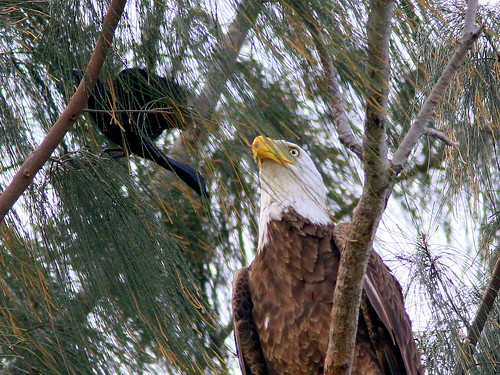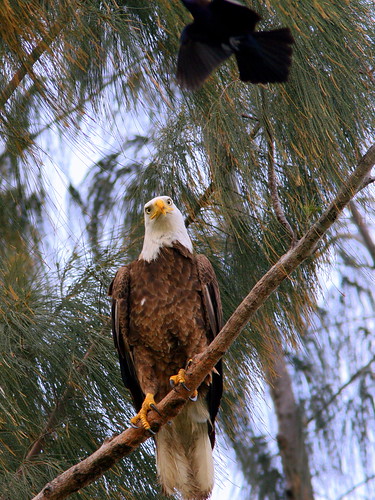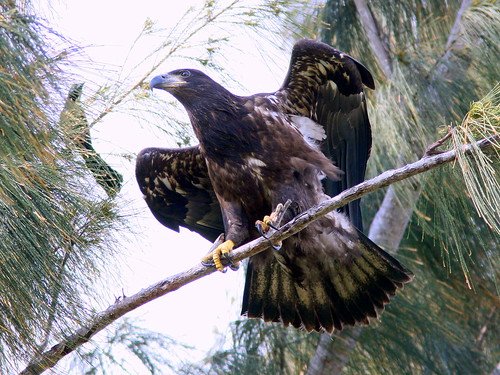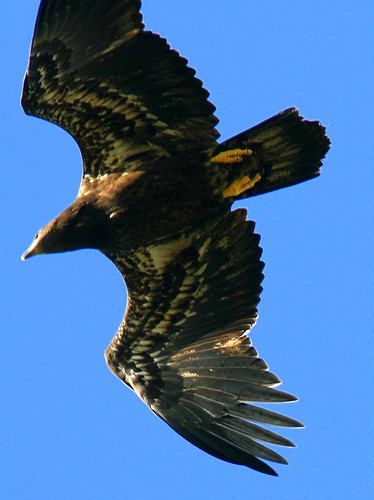Several times, watchers at the urban nest of the Pembroke Pines (Florida) Bald Eagles saw Northern Mockingbirda and Common Grackles approach closely to adult and fledgling eagles, apparently trying to drive them off a favored roosting tree.
Smith, one of the veteran nest observers, captured this video of the action the day before yesterday:
I was shooting the scene next to Smith, and, a few times, saw a grackle actually pull at the adult eagle’s tail feathers. My shutter lag and my (much greater) reaction time made me miss photographing these close encounters, at least one of which appears on Smith’s video.
Here, a grackle makes a very close pass at the eagle’s head:
The adult keeps its eyes on the attacking blackbird, but actually seems passive and never strikes out at it:
Later, a grackle is poised to swoop down on Hope, the larger and older of the 13 week old eaglets:
The young eagle has suffered enough abuse at the hands of a small flock of Common Grackles, and flies away, but one grackle does not give up so easily:
The eaglet flew directly over my head, so fast and low that I could hardly keep it in the camera’s viewfinder:
Why do small birds sometimes seem to put themselves at risk by harassing and even attacking much larger raptors? I have seen fragile little chickadees, titmice, and nuthatches join larger robins and jays to surround and scold a hapless Long-eared Owl or Red-tailed Hawk. Sometimes, mammals such as chipmunks and squirrels join the birds, calling excitedly and flicking their tails nervously.
Red-winged Blackbirds are known perch on the backs of larger hawks to pluck a few feathers as they drive them away from their nesting grounds. In my New Mexico back yard, I once watched several Mountain Chickadees and Bushtits join a group of jays and Clark’s Nutcrackers to take on a Merlin that was perched out in the open. The small falcon could have easily made a meal of even the larger birds, yet it merely held fast to its perch and appeared to be screaming back at the annoying assembly. Many of us have seen mockingbirds attack alley cats, actually striking them on their backs. (In Dallas, I saw a cat turn suddenly to catch and kill a mockingbird doing just this). In Alaska, I was mobbed by Arctic Terns when I approached too close to their nesting colony.
In an earlier Blog about mobbing behavior, I reflected on how crows often reliably led me to roosting hawks and Great Horned Owls, and once, to a Bald Eagle, and remembered that my weak imitation of a Western Screech-Owl caused a large number of smaller forest birds to cluster around my position, and remain for many minutes after I stopped calling. I wrote:
This interesting Wikipedia article goes into some detail about mobbing, and explores possible reason why an action that appears so risky may actually enhance the survival of prey species.
| PEMBROKE PINES BALD EAGLES |
| Nest Watch Page |
| History of the Eagle Nest |
| Protecting the Eagle Nest Site |
| EagleWatch FORUM |
| FAQs |
| Subscribe to this BLOG (RSS) |


















February 24th, 2010 at 3:36 pm Thank you for sharing the progress of the eaglets. I live close by and was very glad to hear that the couple did come back to nest and that this year we have three youngsters. They are so majestic and beautiful, that looking at the pics just takes my breath away. Thanks for sharing.